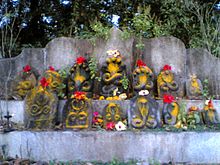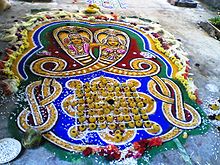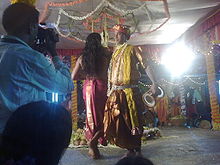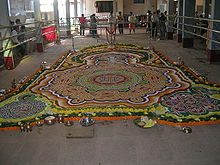- Nagaradhane
-
 Nagabana at Belle Badagumane, Moodubelle, Udupi
Nagabana at Belle Badagumane, Moodubelle, Udupi
Nagaradhane (Tulu:ನಾಗಾರಾಧನೆ) is a form of snake worship which, along with Bhuta Kola, is one of the unique traditions prevalent in coastal districts of Dakshina Kannada , Udupi and Kasaragod alternatively known as Tulu Nadu
Contents
Origin of Nagaradhane
Snakes, especially the cobra have been revered from ancient times all over India. Due to their mysterious appearances and slithering movements, snakes had always been held in awe in India. Snakes find mention in famous religious epics like Mahabharata, Vishnu Purana etc. Hindu Gods like Vishnu and Shiva have been associated with snakes. According to Hindu mythology, Lord Vishnu takes rest under the shade of the giant snake, Adisesha. Lord Shiva wears a snake vasuki around his neck.
It is difficult to trace the origin of Nagaradhane, though the Bunts of Tulu Nadu claim to be kshatriyas of Nagavanshi descent, thus maybe snake worship was popularised by them. Though most rituals of snake worship are done by brahmins, there is not a single Bunt house that does not have a nagabana. Mostly, snakes were seen as a symbol of fertility. Elsewhere in India, snakes are worshiped during the Nagarapanchami Day. They are offered milk (research has shown that snakes are allergic to milk) and thilak is applied on their forehead.
The snake worship rituals practiced in Tulu Nadu are quite unique and different from the other rituals. Snakes have their own snake shrines in a sacred grove known as Nagabana. The shrines have images of cobras carved of stones. Accordingly, nobody is allowed to chop the tree near the Nagabana. It is also believed that snakes, specifically the cobras, are not be harmed or killed by anyone. If harmed, the individual has to perform a ritual to cleanse the sin of killing or harming the snake. The belief is that the individual who refuses to perform the ritual will be cursed by the snake for eternity.
It can also be noted that in Tulu Nadu or the South Canara region in Karnataka, agriculture is predominant that too paddy is the main crop. In these fields snakes help in saving the crop from rodents. This can be a plausible reason for worship of snakes in line with other nature worships such as cow and the banyan tree.
The ritual
 mandala drawn during ashleshabali at Belle Badagumane Moodubelle, Udupi
mandala drawn during ashleshabali at Belle Badagumane Moodubelle, Udupi
There are two distinct rituals performed in reverence to the snake. They are, Aashleshabali and Nagamandala. Of these, Nagamandala is longer and colourful than Aashleshabali. Nagamandala depicts the divine union of male and female snakes. It is generally performed by two priests. The first priest, called as patri inhales the areca flower and becomes the male snake. The second priest, called as Nagakannika or the female snake dances and sings around an elaborate serpent design drawn with natural colours on the sacred ground. The ritual is supplemented by playing an hour glass shaped instrument called as Dakke. The drawings in five different colours on the sacred ground are white (white mud), red (mix of lime powder and turmeric powder), green (green leaves powder), yellow (turmeric powder) and black (roasted and powdered paddy husk). Aashleshabali is similar nature to the after death rituals performed for the humans as per the Hindu tradition.
The ritual, centered around the serpent design, continues till early in the morning. A similar kind of ritual is found in Kerala and is known as Sarpam Thullal and Sarpam Kali. All communities of tulu nadu revere snakes.
Significance of Nagabanas
Nagabanas or the sacred groves are deemed to be the resting place of the Snake God. Cutting of trees or defacing the grove is considered as sacrilege. People are wary of the wrath unleashed by the deity. Nagabanas once remained unspoilt and have contributed immensely to the preservation of valuable trees and medicinal plants in tulu nadu, but not now. With rapid and unplanned urbanisation many nagabanas have disappeared and in their place small temples for serpent god have been built clearing valuable trees and plants.
References
- http://www.udupipages.com/home/temple/naga.html
- http://www.gurjari.net/ico/Mystica/html/snake_worship.htm
External links and videos
- naga possession videos
- naga darshana video
- dakke da bali video
- nagamandala with tulu explanation
- tying the knot
- untying the knot
See also
Culture of Tulu Nadu Yakshagana · Bhuta Kola · Aati kalenja · Kambala · Nagamandala · Dakke Bali · Koti and Chennayya · Hulivesha · Jumadi
Categories:- Dances of India
- Ritual dances
- Tuluva
- Culture of Karnataka
- Snakes
- Hinduism in Mangalore
Wikimedia Foundation. 2010.



